Click on images to enlarge
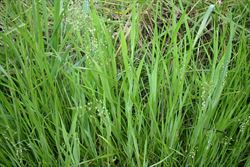
dense infestation (Photo: Sheldon Navie)
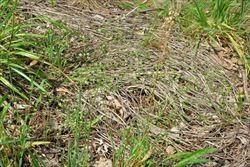
habit (Photo: Forest and Kim Starr, USGS)
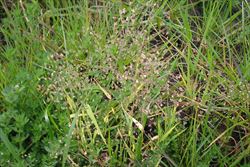
habit (Photo: Sheldon Navie)
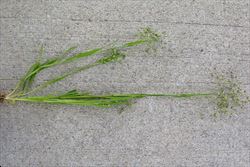
tufted plant with unbranched stems (Photo: Sheldon Navie)
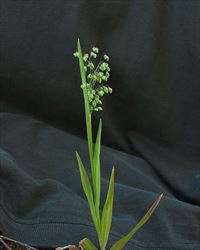
leaves and young seed-head (Photo: Jackie Miles and Max Campbell)
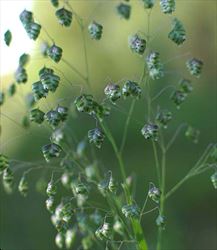
close-up of the small flower spikelets (Photo: Jackie Miles and Max Campbell)

mature much-branched seed-head (Photo: Sheldon Navie)
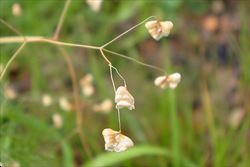
close-up of flower spikelets breaking up at maturity (Photo: Sheldon Navie)
Scientific Name
Briza minor L.
Synonyms
Briza gracilis hort.Briza minima hort. ex Nichols.
Family
Gramineae (South Australia)Poaceae (Queensland, New South Wales, the ACT, Victoria, Tasmania, Western Australia and the Northern Territory)
Common Names
fairy bells, lesser quaking grass, lesser quaking-grass, little fairy bells, little quaking grass, little quakinggrass, quaking grass, shivery grass, shiverygrass, small quaking grass, small shivery grass
Origin
Native to southern Europe (i.e. Albania, Greece, Italy, Yugoslavia, Portugal and Spain), northern Africa (i.e. northern Libya and Egypt) and western Asia.
Cultivation
Like quaking grass (Briza maxima), this species has occasionally been grown as a garden ornamental and for flower arrangements.
Naturalised Distribution
This species is widely naturalised in southern and eastern Australia (i.e. in south-eastern and central Queensland, in eastern and southern New South Wales, throughout Victoria, the ACT and Tasmania, in many parts of South Australia, and in the southern and western parts of Western Australia).
Also naturalised on Lord Howe Island and Norfolk Island, and in many other parts of the world (e.g. other parts of Asia and Africa, New Zealand, Hawaii and the USA).
Habitat
A common weed of disturbed sites, parks, gardens, footpaths, roadsides and waste areas that is also a widespread weed of natural habitats (e.g. grasslands, wetlands, waterways, coastal environs, open woodlands and forests). It prefers fertile, moist and shady habitats in temperate and sub-tropical regions, but also grows in wetter habitats in semi-arid regions.
Habit
A small, upright (i.e. erect), short-lived (i.e. annual) grass which forms soft, loose, tufts. It grows from 5-60 cm tall, but is usually less than 30 cm in height.
Distinguishing Features
- a small short-lived grass usually growing less than 30 cm tall.
- where the leaf sheath meets the leaf blade there is a long membranous structure 2-10 mm long.
- its seed-head is a branched panicle with 3-100 small flower spikelets that tend to 'shiver' in the wind.
- each of the broad spikelets (2-5 mm long and 3-6 mm wide) have several (3-8) tiny florets.
-
the tiny florets break apart separately at maturity.
Stems and Leaves
The stems are unbranched, hairless (i.e. glabrous) and tufted.
The alternately arranged leaves sheath the stem at the base and have a spreading leaf blade. Where the leaf sheath meets the leaf blade there is small membrane-like structure (i.e. a membranous ligule) that is relatively long (2-10 mm long) and bluntly rounded (i.e. obtuse). The leaf blades (2-22 cm long and 1-10 mm wide) are very narrow (i.e. linear) and gradually narrow towards a pointed tip (i.e. acute apex). These leaves are mostly hairless (i.e. glabrous) and their margins are slightly rough to touch (i.e. scabrous).
Flowers and Fruit
The seed-heads (i.e. inflorescences) are open panicles (2-20 cm long) with numerous (3-100) small flower spikelets. The flower spikelets (3-5 mm long and 3.5-5 mm wide) are egg-shaped in outline (i.e. ovate) or somewhat triangular in shape. They are borne on very slender stalks (i.e. filiform pedicels) 5-15 mm long and tend to hang down in a nodding fashion (i.e. they are pendulous). These flower spikelets (2-5 mm long and 3-6 mm wide) consist of a pair of bracts (i.e. glumes) and 3-8 tiny flowers (i.e. florets). The florets consist of two bracts (i.e. a palea and a lemma), three stamens with anthers less than 1 mm long, and an ovary topped with a feathery stigma. Flowering occurs mainly during spring and early summer (i.e. from August to December).
The flower spikelets break up at maturity, usually leaving the glumes behind (i.e. the spikelets disarticulate below each fertile floret). The 'seeds' (i.e. grains or caryopses) are somewhat flattened and about 2.25 mm long.
Reproduction and Dispersal
This species reproduces entirely by seed. Seeds may be dispersed by water, wind or in mud attached to animals and vehicles. They may also be spread about by mowers and slashers and dispersed larger distances in contaminated agricultural produce (e.g. fodder).
Environmental Impact
An environmental weed in Western Australia, Victoria, South Australia, New South Wales, Queensland and Tasmania. Although it may seem relatively harmless, shivery grass (Briza minor) has the ability to invade a range of native vegetation communities, from healthy woodland areas to grasslands and riparian areas. It is capable of rapid colonisation of the ground layer of such communities and forms very dense swards that outcompete and replace native species.
Shivery grass (Briza minor) often occurs in the same areas as quaking grass (Briza maxima) and generally causes the same sorts of impacts. It has commonly been recorded from conservation areas in southern Australia (e.g. in Sir Frederick Samson Park in Fremantle, in Hale Conservation Park, Mount Magnificent Conservation Park and Cromer Conservation Park in South Australia, in Gramatan Avenue Heathland Sanctuary, Arcadia Bushland Reserve and Boonderoo Nature Conservation Reserve in Victoria, and in the Greens Beach/Kelso Coastal Reserve in Tasmania). It is listed as a moderately important environmental weed in the "Environmental Weed Strategy for Western Australia" and is a common weed in threatened shrubland and woodland communities on muchea limestone soils in this state. In South Australia it is a commonly recorded weed species in wetlands on the Fleurieu Peninsula, while in Victoria it is common in coastal habitats and is also one of the most common weeds of threatened grey box grassy woodland communities. Also in Victoria, it is a commonly reported weed species in the remnant plant communities that are home to the threatened Euroa guinea-flower (Hibbertia humifusa subsp. erigens), and weed invasion is considered to be the greatest threat to almost all populations of this rare native plant.
Legislation
Not declared or considered noxious by any state government authorities.
Similar Species
Shivery grass (Briza minor) is similar to Briza subaristata and quaking grass (Briza maxima). These species can be distinguished by the following differences:
- shivery grass (Briza minor) is a smaller plant, usually growing less than 30 cm tall. Its seed-heads have large numbers (i.e. more than 15) of small flower spikelets (3-5 mm long) that are borne on long slender stalks (5-15 mm long). Its tiny florets are mostly rounded at their tips and are not lobed.
- Briza subaristata is a larger plant, growing up to 80 cm tall. Its seed-heads have large numbers of small flower spikelets (1.75-5.5 mm long) that are borne on short slender stalks (2-7 mm long). Its tiny florets are pointed at their tips and also have two pointed lobes on their sides.
- quaking grass (Briza maxima) is a larger plant, usually growing 30-60 cm tall. Its seed-heads have a small number (i.e. 3-15) of large flower spikelets (7-25 mm long) that are borne on long slender stalks (5-20 mm long). Its tiny florets are mostly rounded at their tips and are not lobed.

